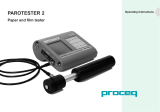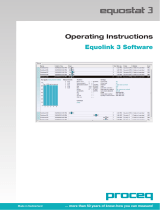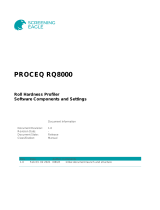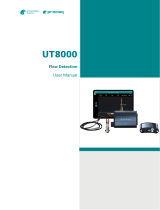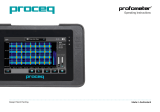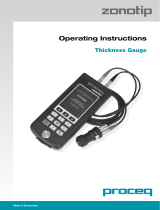Page is loading ...

Maintenance and Service
`Keep the impact device and the indicating device clean.
`Do not lubricate the impact device!
`Clean the tube of the impact device from time to time.
`Check the impact device calibration from time to time. Always recalibrate after
changing the impact body.
For further assistance contact our service: www.proceq.com.
Equolink 3 Evaluation Software
Equotip® 3 is supplied with the PC evaluation software Equolink 3, offering
–transfer of stored data to a PC or network
–advanced data representation and evaluation
–editing, printing and exporting of measurement series
–upgrade of Equotip® 3 firmware.
Many more Functions
The Equotip® 3 has many more useful functions. Just to mention a few:
–Severals ways of representing measured data.
–Displaying and editing stored series of measurements.
–Direct protocol printout to a USB or serial printer, with extended statistics.
–Customer-defined hardness scale conversions.
–User profiles to make the instrument as simple or as complex as desired.
Password protection possible.
–Configurable acoustic signals.
–Configurable power management.
–Fast computer interfaces (USB and Ethernet).
–Multi-language support.
–Context-specific help ( key).
–Background illumination, 5 adjustable levels ( key).
Most of these functions are accessible via the menu structure. Enter menu by pres-
sing the key. Consult the operating instructions for details.
Structure of the Menus
Main Menu
Measurement View Memory Config Help
Direction... F1
Material... F2
Scale... F3
n... F4
Limits...
Close F5
Remove F6
Comment...
Print series
Bar graph
Basic mode
Signal graph
Conversion
function
Display mean x
Set bar graph
range...
Multiple series
bar graph
Scale bar width
Save series
Set series file
name... #
Set save
folder...
Explorer...
Properties...
Language...
User interface...
Display...
System
settings
User profiles
Signal
compression...
Customer
conversions
Calibrate
probe...
About
EQUOTIP3...
Show help
index... ?
Show help
content... ?
Show system
info...
Conversion
standard...
Charging the Battery
`Connect the mains adapter to the AC power supply outlet and to the power sup-
ply jack of the instrument.
ªThe battery will start charging. The charging state is indicated by the green
status LED.
`Charge the battery until the status LED goes OFF.
ªA fully charged battery lasts for approximately 10 hours.
If the power of the rechargeable battery is too low, the battery symbol on the display
flashes.
Starting up the Unit
`Lift the rubber flaps to uncover the connection ports.
`Connect the impact device to the 20-pole input socket (2) of the indicating
device.
`Press the ON / OFF key until the display activates.
ªWhile the device is booting, a splash screen appears on the display.
ªThe Equotip® 3 is now ready for the first measurement.
If the battery power is low:
`Connect the mains adapter to the AC power supply outlet and to the power sup-
ply jack (6) of the device.
ªThe battery will start charging. The green LED turns on.
Quick Reference Guide
820 35 302E ver 07 2012 © Proceq SA, Switzerland. All rights reserved.
This Quick Reference Guide is meant to be a brief operation aid.
Careful reading of the operating instructions is mandatory.
Display
1
910 12 13 14
345
67
8
11
2
1
2
3
4
5
6
7
8
9
10
11
12
13
14
Date and time
Tolerance limits (not set)
Mean value indicator (disabled)
Automatic storage (disabled)
Type of connected impact
device (D)
Interface status
(Printer, Ethernet, USB)
Battery / power supply status
(charging)
Active navigation keys
Impact direction
(automatically detected)
Material class
Context-specific function keys
Hardness scale (HLD)
Automatic finishing of measure-
ment series after n(5) readings
Name of measurement series
Arming
`Depress the loading tube carefully until contact is felt.
`Allow it to slowly return to the starting position.
ªThe device is now ready for hardness testing.
Positioning
`Hold the impact device near the support ring and place
it firmly on the test surface.
Testing
`Trigger the impact by exerting light pressure on the
release button. Take care not to compress the spring.
ªThe impact body is released and launched onto the
test surface with a defined energy.
ªThe result is immediately shown on the display.
`Repeat the procedure for the next impact.
CAUTION: In order to avoid incorrect readings:
`Do not perform an impact in an area that has already been deformed by a
previous impact.
`Arm the unit and trigger the impact on two separate positions on the test surface.
`Medium and light-weight test pieces (see table on
p. 104 of the operating instructions) or pieces with
protruding parts must be coupled to a large support.
Measuring Procedure
Connection Ports
1234
5
6
1RS232 connection for printer 4USB port (Device) for PC
220-pole input socket for Equotip®
impact devices
5Ethernet connection
6Power supply jack
3USB port (Host) for mouse or printer
All information contained in this documentation is presented in good faith and believed to be correct. Proceq SA
makes no warranties and excludes all liability as to the completeness and/or accuracy of the information. For the use
and application of any product manufactured and/or sold by Proceq SA explicit reference is made to the particular
applicable operating instructions.
... more than 50 years of know-how you can measure!

Test Requirements
Surface preparation
–Clean, dry and smooth test surface required.
–The roughness of the finished surface should not exceed the following values:
Impact device type Roughness measure
RtRa = CLA = AA
D, DC, DL, E 10.0 µm / 400 µin 2.0 µm / 80 µin = N7
G30.0 µm / 1,200 µin 7.0 µm / 275 µin = N9
C2.5 µm / 100 µin 0.4 µm / 16 µin = N5
Legend
Rt = Roughness depth (DIN 4762)
Ra = Average roughness value (Germany)
CLA = Center line-average value (Great Britain)
AA = Arithmetical average (USA)
N5, N7, N9 = Roughness classification according to ISO/R 1302
`Avoid heat or surface deformation while preparing the test surface.
ªExcessive scattering of test results indicates poor surface preparation.
Series of Measurements
For reliable results, the mean value of at least 3 to 5 measured values in the test area
should be taken.
Defining standard series size
`Press the key.
ªDialog box “Close series after...” opens.
`If not yet enabled, select “Automatically close”.
`In the ”after n =” input field, enter the number of required readings by increasing
or decreasing the current number with the or key, respectively.
`Press the key to close the dialog box.
ªThe series of measurements will automatically be closed once the specified
number of measurements has been reached.
If no automatic termination of the series of measurements is desired, select “Manually
close …”.
Deleting readings from a series
`Use the arrow keys to select the reading to be deleted.
`Press the key.
`Confirm by pressing the key.
If no reading is selected, pressing will delete the last value.
Terminating a series manually
You can manually close the current series of measurements at any time.
`Press the key.
ªThe current series is closed and the series statistics are displayed.
Extending a closed series
A closed series of measurements can be reopened in order to add more readings.
`Press the key.
ªThe current series is reopened. The statistics disappear.
New series
If the current series is closed (statistics displayed), press or perform the next
measurement to open a new series.
Displaying the current mean value
The value displayed on the upper right is either the last single reading (no indicator) or
the current mean value of the series (with the mean symbol in front).
`Pressing the key switches between these settings.
Impact device position and curved areas
`Avoid tilting or movement of the probe while testing.
Special support rings for testing convex or concave curved surfaces
(R < 30 mm, 1.2 in) are available.
Conversion to Standard Hardness Scales
The Equotip® 3 provides approximate conversion of measured HL values to all popu-
lar standard hardness scales (HB, HV, HRA, HRB, HRC, HS and tensile strength Rm
for steel).
CAUTION: Hardness scale conversions are material-specific.
Always specify the material to be tested before setting the hardness scale.
If the desired scale is not available for the material in question, never specify a diffe-
rent material class. Unpredictably large conversion errors may result!
Selecting the material
If the current series is closed (statistics displayed), press to open a new series
or to reopen.
`Press the key.
`Select the adequate material class.
For more information about material classes press the key or consult the opera-
ting instructions.
`Press the key to confirm your selection.
Selecting the hardness scale
Ensure that the appropriate material classes are selected!
`Press the key.
`Select the desired hardness scale.
`Press the key to confirm your selection.
ªAll hardness values are displayed in the selected scale.
For specification of customer-generated conversions consult the operating instructions.
Tolerance Limits
Equotip® 3 allows you to specify a tolerance range.
`Ensure that the desired hardness scale has been selected (for the correct
material!).
`Select menu item “Measurement” -> “Limits …”.
To set the upper limit:
`Check “Enabled” in the upper row. Move to the input field and enter the lower
limit value in the selected scale using the or key or a soft keypad which
is activated by pressing the key.
To set the lower limit:
`Proceed the same way with the second row.
`Press the key and confirm by pressing the key.
ªThe limit(s) are active. Readings outside the specified range will be marked by
“+” or “-”.
Impact Direction Compensation
Due to the measurement principle, raw Leeb hardness values depend on the impact
direction. With Equotip® 3 impact devices, the instrument is capable of compensating
for this effect automatically. In addition, manual setting of the actual impact direction
is supported.
`Press the key.
`Select either “Automatic” or one of five fixed impact directions.
`Confirm your selection by pressing the key.
The impact direction can be set for individual readings, even later on. Just select the
reading and specify the impact direction as described above.
For calibration of the automatic direction compensation refer to the operating instruc-
tions.
Storing Data
The Equotip® 3 is equipped with a large storage for measured data, including instru-
ment and probe serial numbers, time stamps, statistics, all relevant settings and an
optional comment.
`To enable storing, just press the key.
ªThe name of the series is displayed to the right of the first status line (14). The
series will be stored under this name as soon as it is closed.
Series of measurements can be given freely selectable alphanumeric names.
In order to change the name of the series:
`Press the key.
ªA keypad is displayed.
`Enter the desired name. (The same name with the last character increased by one
will be used for the next series.)
`Press the key.
Pressing the key again disables storing.
Measured data can be stored in a hierarchical directory structure. For details see the
operating instructions.
... more than 50 years of know-how you can measure!
/

